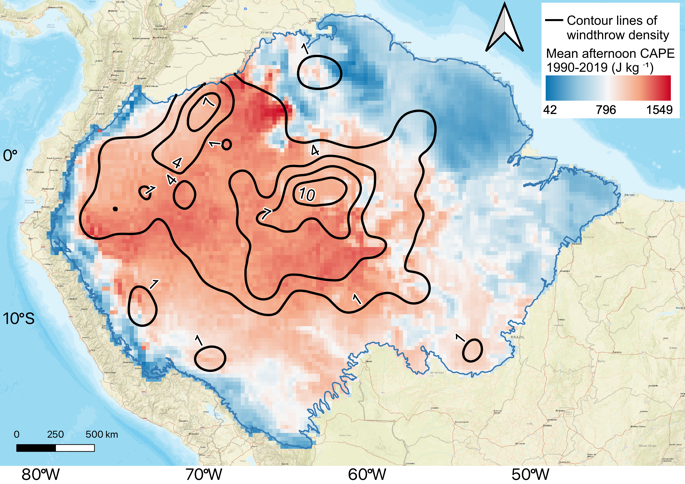The connection between convective storms and tree mortality in the Amazon projects a large increase in future windthrow events.
The Science
A leading cause of tree mortality in the Amazon is windthrow, i.e., tree broken or uprooted by high winds and heavy rainfall in an extreme storm. Here we built a linkage between extreme storms in the atmosphere and forest mortality on the land surface. Global warming makes extreme storms more intense, and using this linkage, the projected storms are likely to make tree mortality by windthrow commonplace over about 50% more of the Amazon by the end of the century.
The Impact
Amazon forests play important roles in regulating global carbon cycle, but variable natural disturbances increase the uncertainty of the carbon capacity. Extreme storms are important drivers of tree mortality in the Amazon region. In this study, we provide a framework for representing the coupling between forest mortality on the land surface and extreme storms in the atmosphere. This analysis highlights the potential for predicting the rate of future storm-driven tree mortality, a driver of tree mortality that currently is not included in global models and emphasizes the need to improve land-atmosphere relationship in models.
Summary
Forest mortality caused by convective storms (windthrow) is a major disturbance in the Amazon. However, the linkage between windthrows at the surface and convective storms in the atmosphere remains unclear. In addition, the current Earth system models (ESMs) lack mechanistic links between convective wind events and tree mortality. In this study, we manually map 1012 large windthrow events encompassing 30 years from 1990-2019 and generate hourly convective available potential energy (CAPE, which represents the environment to produce storms) from ERA5 reanalysis data. Here we find an empirical relationship that maps CAPE, which is well simulated by ESMs, to the spatial pattern of large windthrow events. This relationship builds connections between strong convective storms and forest dynamics in the Amazon. Based on the relationship, our model projects a 51% ± 20% increase in the area favorable to extreme storms, and a 43 ± 17% increase in windthrow density within the Amazon by the end of this century under the high-emission scenario (SSP 585). These results indicate significant changes in tropical forest composition and carbon-cycle dynamics under climate change.

Contact
Yanlei Feng, University of California, Berkeley, ylfeng@berkeley.edu
Jeffrey Chambers, Lawrence Berkeley National Lab, jchambers@lbl.gov
Funding
This research was supported as part of the Next Generation Ecosystem Experiments-Tropics, funded by the U.S. Department of Energy, Office of Science, Office of Biological and Environmental Research under contract number DE-AC02-05CH11231. We acknowledge the World Climate Research Programme, which, through its Working Group on Coupled Modelling, coordinated and promoted CMIP6. We thank the climate modeling groups for producing and making available their model output, the Earth System Grid Federation (ESGF) for archiving the data and providing access, and the multiple funding agencies who support CMIP6 and ESGF.
Publications
Feng, Y., et al., “Amazon windthrow disturbances are likely to increase with storm frequency under global warming”. Nature Communications, 14(1), pp.1-8, (2023), [DOI: 10.1038/s41467-022-35570-1]
Related Links
Climate Change Likely to Uproot More Amazon Trees, News from Berkeley Lab
Storms are a major source of forest mortality in the Amazon, Earth.com
Thunderstorms Caused by Climate Change Will Most Likely Increase the Number of Large Windthrow Events in the Amazon, Nature World News